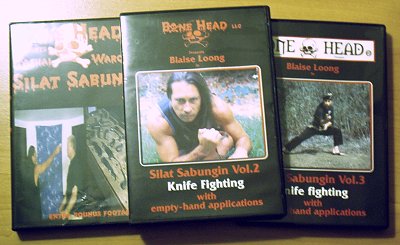its paid sponsors, whose products you need!
| Home |
| Intro |
| Current Issue |
|
Mailing List |
| Store |
| Strength |
| Subscriber Content |
| ARCHIVES
|
| Martialism |
| Pacifism |
| Q & A |
| Cunning-Hammery |
| Advertise With Us |
| Submit An Article |
| Staff |
| Discussion Forum |
| Links |
“Stay ‘unreasonable.’ If you
don’t like the solutions [available to you], come up with your
own.”
Dan Webre
The Martialist does not
constitute legal advice. It is for ENTERTAINMENT
PURPOSES ONLY.
Copyright © 2003-2004 Phil Elmore, all rights
reserved.
Silat Sabungin
A Video Review by Phil Elmore
The three-volume
Silat Sabungin DVD
set is Blaise Loong’s articulation of “the Filipino-Malay art of short knife
and empty hand fighting.” As luck would have it, I approach this review
having relatively recently started lessons in Silat myself. The lessons
give me a good grounding in the same concepts related in the DVDs, which I
found to be an excellent primer on Silat as well as the use of the short blade
for self-defense.

Silat Sabungin DVDs from Bonehead LLC.
The DVDs each have very good graphic menus dividing the
topics covered (and allowing the video student to go to and review any of
these at will). Volume One also has graphic blocks with titles at the
beginning of each segment (Volumes Two and Three lack these). Video
quality is largely good, with the background used in Volume Two an improvement
over the darker background in Volume One. Sound levels are generally
audible but a little hollow, with one or two very quiet spots. Extensive
use is made of dramatic and tribal music and other effects, giving the DVDs a
melodramatic flair that I found kind of charming.
As an instructor in this medium, Blaise is a little stiff on
camera, delivering his narration in a flat tone that is also very calm and
easy to follow. As time goes on and we make the transition from volume
to volume, he warms up a bit and becomes a little more animated vocally.
Physically, he’s extremely comfortable with his subject matter, flowing
through his demonstrations with confidence and vigor. Live knives are
used on camera, which says something about Blaise and his level of skill.
(Personally, I wish he’d emphasized more the safety concerns of such training,
but I’m very uptight about such things. He does caution the viewer to be
careful of his or her partner.)
Extensive use is made of slow-motion demonstrations set to
music, from footage taken outside to demos done to punctuate the instructional
segments. The DVDs have an artistic flair to them not shared by more
workmanlike videos in this genre. Obviously, the editor of the volumes
loved his work and went about it enthusiastically.
Volume One
As Volume One opens, Blaise explains that Silat Sabungin is
based on ancient cockfighting sports. The knives he shows the viewer are
variations on this theme — short, pointed talons whose emphasis is on the
point rather than on a cutting edge. Blaise then explains and
demonstrates the applications of three basic “attack typologies.” These
are the rip, the peck, and the tear.
The rip mimics the action of a claw or talon, dragging the
point of a short knife through the opponent’s flesh. The peck mimics a
beak attack; the point is thrust into the opponent and withdrawn along the
same trajectory. The tear combines these two attacks to insert and then
tear free the blade.
After explaining these typologies, Blaise combines them and
demonstrates applying all three to flow with the attack. He then moves
on to the three basic entry typologies, which will hold no surprises for those
familiar with Silat: inside, outside, and split.
As you might expect, the inside entry involves entering to
the open area of the opponent’s body, while the outside entry involves moving
to the blind side. The split entry is epitomized by the gunting
(scissors), attacking both the inside and outside at once. The
discussion and demonstration of the inside entry includes the ascending and
descending wings. Basic footwork is evident throughout.
“Finesse is the name of the game with this weapon system,”
Blaise intones. He explains that learning the weapon enhances your empty
hand skill and gives you that finesse.
Volume One includes a good recap of the topics covered
(Blaise is good about reviewing what he’s taught to help the viewer pull it
all together) and some commentary on the philosophy of Silat Sabungin.
“Concentrate on utilizing the weapon for now,” Blaise says as he demonstrates.
“Focus on the blade. Think about your targeting — outside, split, and
inside. You want pain, shock, blood, damage to your opponent.
Remember, he could be armed — especially when it’s multiple opponents, you
want an equalizer.”
The DVD concludes with more music and demonstration footage,
a thank-you to Jesus Christ, and promos for other videos sold by
Bonehead LLC.
Volume Two
After a lengthy and artistic intro, Volume Two begins with
Blaise explaining what’s to come. He tells the viewer that he’ll be
covering offensive and defensive drills that will help viewers apply Silat
Sabungin in both sparring and combat.
First, Blaise concentrates on the peck and on a jab-cross
combination targeting the throat. He then demonstrates the catch, using
his palm to absorb an incoming strike. After this he demonstrates the
short parry and the long parry (a controlling version of the parry) before
combining all three defenses in an exercise that helps develop timing and
application.
The fourth defensive movement demonstrated is the cover,
which will look familiar to many RBSD (reality based self-defense)
practitioners conversant in “shields” or “cowcatchers” or other variations on
using the forearm to protect the head. The last technique is the evasion
— moving your body and your head to avoid strikes.
Armed and unarmed applications of the concepts covered to
this point lead to a demonstration of using specific entry techniques with the
attack typologies and defensive motions. The DVD concludes with a
montage of training sequences set to music.
Volume Three
 Volume
Volume
Three was filmed in some sort of garage or warehouse space. Blaise
briefly recaps the material covered in Volumes One and Two. The focus of
the third volume is takedowns — knocking your opponent to the ground through
leg moves and head maneuvers.
If you are familiar with “sticky leg” techniques in Silat or
in other styles, the leg maneuvers will be nothing new to you. Blaise
explains and demonstrates an inside toe pick, an outside toe pick, inside and
outside heel trips, and several head manipulations. The latter involve
pushing the head in order to maneuver the trunk – -a concept I’ve covered in
my own Silat training.
As Blaise and his partner work on the cold, hard floor of
this training space, some of the true viciousness of this particular style
comes through. Blaise works over his opponent very thoroughly and ties
the takedowns to various entry techniques. The viewer is also treated to
a brief explanation of the variations and stylistic differences in the arts
Blaise has studied.
In a segment on short knife application, Blaise ties
everything together once again, using blades and the techniques discussed to
defend himself viciously and effectively. He speaks a bit on the “old
school” training he’s had and how it applies. His teachers wanted
students trained in context to understand the seriousness of it.
The DVD ends, like the others, with a demo among students.
Silat Sabungin
This is good material. While it does not spoon-feed
the viewer with the explicit philosophy he or she must adopt to use the blade
(and the skills of the blade) for effective self-defense, this is easily
identifiable and accessible. Blaise imparts the basics of Silat Sabungin
in a methodical, well-ordered fashion, leaving the viewer (even the beginning
student) with useful baseline skills. The short knife typologies are
easily transferable to improvised weapons like pens or other stabbing tools.
The gravity of armed combat is also sufficiently communicated in the
DVDs.
I find Mr. Loong’s DVDS
entirely satisfactory and would recommend them to interested students of the
knife and of Silat.
